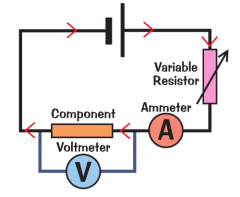![]()
![]()
![]()
Use LEFT and RIGHT arrow keys to navigate between flashcards;
Use UP and DOWN arrow keys to flip the card;
H to show hint;
A reads text to speech;
27 Cards in this Set
- Front
- Back
|
What is current?
|
The rate of flow of charge around a circuit.
|
|
|
What is current measured in?
|
Amperes (A)
|
|
|
What does current need to flow?
|
Voltage!
|
|
|
What is Voltage?
|
The driving force that pushes current around. like electrical pressure.
|
|
|
What units is voltage?
|
V
|
|
|
What is resistance?
|
Anything that slows flow down. If you add more components to the circuit there will be more resistance.
|
|
|
What units for resistance?
|
Ohm see page 21
|
|
|
What is the balance between voltage and resistance?
|
Voltage tries to push current around circuit. Resistance opposes the flow of current. The relative size of voltage and resistance affect how big current will be.
|
|
|
What happens if you increase voltage?
|
More current flows
|
|
|
What happens if you increase resistance?
|
Less current flows OR more voltage needed to keep same current!!
|
|
|
What is an Ammeter?
|
Measures the current in amps flowing through a component .
|
|
|
Should an ammeter be in series or parallel?
|
In series. We want to measure the current after it has passes through the component
|
|
|
What is a voltmeter?
|
Measures voltage ACROSS a component
|
|
|
Should voltmeter be series or parallel?
|
Parallel. Must be placed around the component under test so as not to add any resistance and not affect current.
|
|
|
Draw the standard test circuit
|

Here I am!
|
|
|
Should an ammeter be connected in parallel or series
|
series as measures amount of electrical flow in circuit. very low resistance so can be in series
|
|
|
What is the standard circuit used for?
|
Testing components and getting V-I graphs
|
|
|
What must be in series
|
The component under test. the ammeter and the variable resistor. They can be put in any order in circuit!!
|
|
|
If you add components with resistance does the current reduce after each component?
|
NO!! The overall current across all components is reduced the same
|
|
|
What happens as you vary a variable resistor?
|
It alters the current flowing through the circuit. This allows you to take several pairs of readings from the ammeter and voltmeter. you can then plot these on V-I graph
|
|
|
What type of current is mains supply and battery
|
AC for mains, DC for current
|
|
|
What voltage is UK mains supply
|
230v
|
|
|
What does AC mean
|
alternating current. means it is changing direction constantly
|
|
|
What's so special about AC?
|
Its current can be increased or decreased by a transformer. so in power lines the lower the current, the less energy is wasted as heat
|
|
|
Does voltage drop as you go around a circuit, through each component?
|
Yes! From positive to negative it will drop through each component with some resistance (bulbs, motors etc.)
|
|
|
What happens to three bulbs connected in series
|
They all are equally dimmed as voltage drops and all get 1/3 current
|
|
|
What happens to three bulbs in parallel
|
they are all equally bright. Each bulb gets full voltage and current
|

